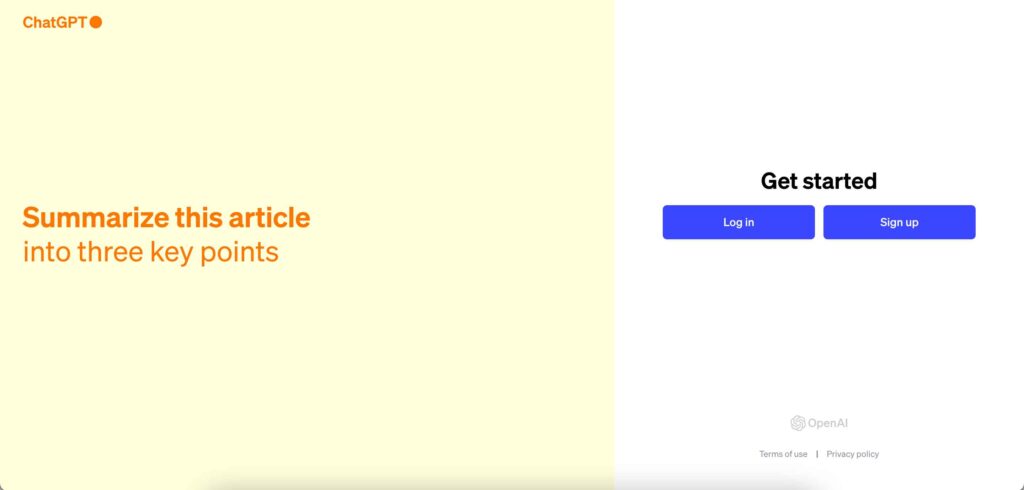Copy AI vs ChatGPT: Which AI Writing Tool Is Better?
Artificial Intelligence (AI) is increasingly making waves in modern businesses, and among its many applications, AI writing tools have radically transformed content creation. Two noteworthy contenders in the AI writing industry are Copy AI and ChatGPT. The question of “Copy AI vs. ChatGPT” might arise for those in the market for an AI writing assistant that augments their content creation and simplifies the writing process while enhancing productivity.
Choosing the right AI writing tool can be a game-changer. Good content creation requires time, innovation, and effort. With the right tool, you can reduce stress, save time, and focus more on strategizing and less on drafting. Thus, which is better between “Copy AI vs ChatGPT” depends on which tool better serves your unique needs.
In this blog post, we aim to provide a detailed analysis of these two powerful writing tools to help individuals and businesses make an informed choice. This comprehensive review will explore various factors like functionality, user-friendliness, pricing, and quality of the content produced. So, let’s dive into Copy AI vs ChatGPT and discover the tool that will truly cater to your content creation demands.
The Tale of Copy AI

Copy AI has firmly established its presence in the vast spectrum of AI-powered writing tools. But what exactly is Copy AI? It’s an AI-based platform designed to help with almost all forms of content creation. It is built upon advanced machine learning algorithms to assist in writing blogs, social media posts, marketing copies, and more, acting as your virtual copywriting assistant.
As for its unique features and capabilities, Copy AI impresses with its versatility and efficiency. Armed with a strong machine-learning backbone, it understands your requirements and suggests a copy that aligns with your desired tone, style, and context. It’s capable of generating multiple suggestions for a single prompt, providing the user with a variety of choices to pick from. Another pivotal feature is its capability to create content in various languages, breaking the language barrier in content creation.
In terms of applications, Copy AI is not restricted to any particular industry. From marketing agencies that constantly need engaging copy to e-commerce businesses that require catchy product descriptions, Copy AI caters to a wide spectrum of sectors. Even individual content creators, such as bloggers or independent marketers, find the wide-ranging features to assist greatly. It’s not just a tool – it’s an all-in-one content solution shaping the future of digital copywriting.
Unveiling ChatGPT

Let’s explore the world of ChatGPT and better understand what it entails, how it can be used, and the unique elements that make it stand out.
Firstly, what is ChatGPT? Simply put, it’s an innovative AI-powered tool developed by OpenAI, designed to understand and generate human-like text. It’s built on a GPT (Generative Pretrained Transformer) technology, enabling it to create diverse and fine text, making it an excellent virtual companion for drafting everything from emails to essays.
Diving into its core functionalities, ChatGPT shines in several ways. It’s an expert resource for drafting and editing content, brainstorming ideas, learning new topics, and even language translation. But it doesn’t stop at text generation; its conversational capabilities make it an engaging tool for those seeking interactive learning methods and personalized AI interactions.
What distinguishes ChatGPT from others? Its impressive ability to produce contextually aware responses sets it apart. Also unique to ChatGPT is its iterative model refinement, involving extensive human feedback during development, which allows it to learn and improve continually, enhancing its textual understanding over time.
Head-to-Head Showdown (Copy AI vs ChatGPT)
Now, let’s dive into the head-to-head showdown, pitting Copy AI vs ChatGPT, and evaluate them in three key areas: content quality, customization and control, and pricing and accessibility.
A. Content Quality
Copy AI and ChatGPT both excel in generating creative, meaningful, and relevant text. While Copy AI excels in marketing and business-oriented content, ChatGPT demonstrates its strengths in producing contextually aware and engaging pieces.
As for user feedback and testimonials, it’s evident that both products have found acclaim in their respective domains. Copy AI frequently earns praise for its ability to create versatile content in various industries, while ChatGPT has garnered appreciation for its high-quality and engaging text generation.
B. Customization and Control
In flexibility, ChatGPT vs Copy AI leaves users with an interesting choice. Copy AI showcases its prowess in providing many content types and templates, while ChatGPT shines with its conversational capabilities and interactive interface.
Both platforms have provisions to alter tone, style, and context for fine-tuning options and user control. However, ChatGPT takes it further by allowing more natural back-and-forth interactions, achieving better quality with iterative inputs.
C. Pricing and Accessibility
Regarding cost considerations, Copy AI vs ChatGPT presents different options for users. Copy AI offers various pricing tiers, apt for businesses and individual users. ChatGPT has a subscription model includes a free tier and a more comprehensive tier for power users.
As for accessibility, Copy AI’s user-friendly interface simplifies content creation, while ChatGPT extends its reach with a hands-on API for developers to incorporate the tool into their applications, providing more varied accessibility.

V. Real-World Success Stories
To truly compare Copy AI vs ChatGPT, let’s delve into real-world success stories, seeing how they’ve positively impacted users in different scenarios.
A. Case Study 1: Triumphs with Copy AI
Creating engaging web content for a newly launched online store can be challenging. This dilemma was faced by a small e-commerce business that needed diverse product descriptions while maintaining a consistent brand voice. With Copy AI, they created outstanding product descriptions and received positive feedback on their innovative marketing copy. Copy AI was a game-changer, increasing their website traffic and boosting sales.
B. Case Study 2: ChatGPT in Action
On the other hand, ChatGPT found its success in education. An online educator utilized ChatGPT to create interactive modules for English language learners. Students could engage with the AI to practice reading and writing, receiving immediate feedback. Not only did this make learning more enjoyable, but students also significantly improved their English proficiency tests. This displays how ChatGPT can be a powerful educational tool, transforming how users learn and interact with information.
C. Comparing Tangible Outcomes and Results
When assessing tangible outcomes in the Copy AI vs ChatGPT debate, the results are indeed intriguing. While Copy AI boosted an e-commerce business’s sales by enhancing the quality and diversity of its product descriptions, ChatGPT played a significant role in improving student learning outcomes in an online education setting.
The success stories emphasize that both tools have unique capacities in different environments. Regardless of the context, both Copy AI and ChatGPT have demonstrated their ability to significantly improve outcomes, whether they are business-related or in the realm of education. Consequently, both serve as powerful tools in the right hands and circumstances.
Ethical and Responsible AI Usage
The rise of tools like Copy AI and ChatGPT has paved the way for an important discussion on the need for ethical and responsible AI usage.
A. The Imperative of Responsible AI Usage
The use of AI carries an inherent responsibility, considering its potential impact on both individual users and broader societies. Whether generating content with Copy AI or engaging in interactive learning with ChatGPT, these tools must be used with mindfulness and respect for ethical guidelines.
B. Addressing Ethical Concerns and Considerations
There’s no denying that AI, including Copy AI and ChatGPT, has its ethical concerns. These may include issues like user data privacy, consent, or concerns about the misuse of AI-generated content. It’s important that users and developers pay attention to these considerations to maintain trust and integrity in AI.
C. How Both Tools Align with Ethical AI Principles
Copy AI and ChatGPT testify to how AI can align with ethical principles. Copy AI and ChatGPT emphasize user data privacy with stringent guidelines to secure user-generated inputs and feedback. Furthermore, they have measures in place to monitor and limit the use of the software for generating misleading or harmful content.
User Experience and Interface
Let’s explore another integral part of the Copy AI vs ChatGPT evaluation – their user experience and interface.
A. User-friendliness and learning curve
Navigating a platform can significantly impact user experience and satisfaction. Comparing Copy AI vs ChatGPT, both tools have taken deliberate steps to ensure their platforms are user-friendly. Copy AI supports a straightforward interface where users choose a desired content type and provide some basic input. ChatGPT operates in a conversational mode, enabling users to type in prompts and receive AI-generated responses. Both tools have manageable learning curves, allowing users to utilize their functionalities easily.
B. Evaluating the tools from a user perspective
Stepping into the shoes of users, it becomes evident that each tool is designed with the user’s needs in mind. Copy AI’s interface, loaded with various formats, makes it an ideal solution for diverse content creation needs. On the other hand, ChatGPT’s conversational format makes it feel like a dynamic, interactive process rather than a tool – perfect for those seeking engaging, AI-powered interactions.
C. The strengths and weaknesses of each interface
Examining the strengths and weaknesses, we find that while Copy AI brings a treasure trove of content creation templates, its plethora of options might overwhelm some users. On the other hand, ChatGPT’s main strength lies in its interactive and fluid platform. However, users needing structured content might need more clarification on the open-ended interface.
Both Copy AI and ChatGPT have considered optimizing their interfaces for user-friendly experiences. Each has its charm and strengths, with a few areas of potential improvement. As with many comparisons, the decision on which is better between Copy AI vs ChatGPT often depends on individual needs, preferences, and comfort with the AI tool’s user interface.
Future Prospects and Developments
Peering into the future of Copy AI vs ChatGPT illuminates exciting prospects and potential advancements that could reshape how we interact with these AI tools.
A. Potential Advancements on the Horizon for Copy AI
For Copy AI, continued development and enhancements are expected. There is potential for richer and more diverse content generation options along industry-specific lines, making the tool even more versatile. Additionally, with growing AI capabilities, Copy AI may offer more nuanced control over the generated copy’s tone, style, and context, giving users a truly personalized content creation experience.
B. Insights into ChatGPT’s Evolving Capabilities
Switching the lens to ChatGPT, there’s a wealth of evolutionary paths this tool could take. With OpenAI at its helm, ChatGPT is projected to improve its comprehension and contextually aware interactive capabilities. Future releases may grasp complex user inputs, offer more interactive conversational experiences, and use multiple languages. Furthermore, ChatGPT’s integration into various applications is highly probable, with AI innovation accelerating.
C. The Implications of Future Changes on the Competition
With these potential developments in mind, the Copy AI vs ChatGPT debate is poised to be even more dynamic. Both tools are poised to evolve, enhancing user experience and stirring competitive forces. Future advancements in Copy AI and ChatGPT will no doubt inspire new features and capabilities, fostering a healthy competition that ultimately benefits the users.
Recommendations and Decision-Making
In the final analysis of Copy AI vs ChatGPT, it’s crucial to provide recommendations that help potential users make informed decisions.

A. Factors to Consider When Choosing Between Copy AI and ChatGPT
Several key factors should guide your decision when comparing Copy AI and ChatGPT. Firstly, consider the primary use case – are you looking to generate creative, diverse content (Copy AI) or looking for a tool that simulates human conversation and interaction (ChatGPT)?
Other factors include the learning curve, cost, data privacy considerations, and the regularity of updates provided by the developers. Each tool has unique strengths, and the choice ultimately lies in aligning these with your needs and priorities.
B. Guidance Tailored to Various Use Cases and Preferences
Copy AI presents an effective solution with a wide range of content templates for businesses focusing on marketing copy or content creators needing inspiration. Conversely, for educators, customer service providers, or AI enthusiasts seeking state-of-the-art conversational AI, ChatGPT emerges as the top option. Therefore, the best tool varies significantly depending on the use case and individual preferences.
C. Expert Opinions and Industry Insights
Consulting expert opinions can prove invaluable in the Copy AI vs ChatGPT decision-making process. Industry insiders generally agree both tools show substantial promise. However, they emphasize that it’s essential to keep abreast of developments within AI and its ethical implications, as continued advancements are expected to revolutionize these tools continually.
Frequently Asked Questions (FAQs)
What are the main differences between Copy AI and ChatGPT?
Copy AI is primarily designed for content creation. The AI writing tool provides users with diverse templates for different types of content. ChatGPT, however, is intended to engage in conversational interactions, making it more suited for creating dynamic dialogues.
In terms of content creation, how do Copy AI and ChatGPT compare?
Copy AI focuses more on structured content across various formats, while ChatGPT is designed to respond to prompts with more conversational and contextually aware content.
How does the user experience differ between Copy AI and ChatGPT?
Copy AI provides a straightforward interface where users choose a desired content type and provide some basic input, while ChatGPT operates in a conversational mode.
Which tool, Copy AI or ChatGPT, provides more diverse content generation options?
While both tools offer diverse content generation, Copy AI has a more extensive array of templates for content needs. ChatGPT, however, excels in generating interactive and fluid conversations.
What are the unique strengths and weaknesses of Copy AI and ChatGPT?
Copy AI excels with its wide variety of content templates but can overwhelm it with options. ChatGPT’s strength lies in its dynamic conversation capabilities, but it might need to be more complex for structured content needs.
What factors should I consider when choosing between Copy AI and ChatGPT?
Consider your primary use case, learning curve, cost, data privacy considerations, and the regularity of updates from developers.
How do Copy AI and ChatGPT handle user data privacy and security?
Copy AI and ChatGPT prioritize user data privacy, ensuring user-generated inputs and feedback are secured.
Conclusion
When comparing Copy AI and ChatGPT, it’s essential to remember that the “better” choice depends on your personal needs and preferences. Copy AI reigns supreme for diverse content creation, while ChatGPT excels at simulating human-like conversations.
Ultimately, the victor in the Copy AI vs ChatGPT debate hinges on your unique requirements and desired use case. Both tools offer impressive capabilities but serve distinct purposes; understanding this distinction will pave the way to making a well-informed, beneficial decision.



